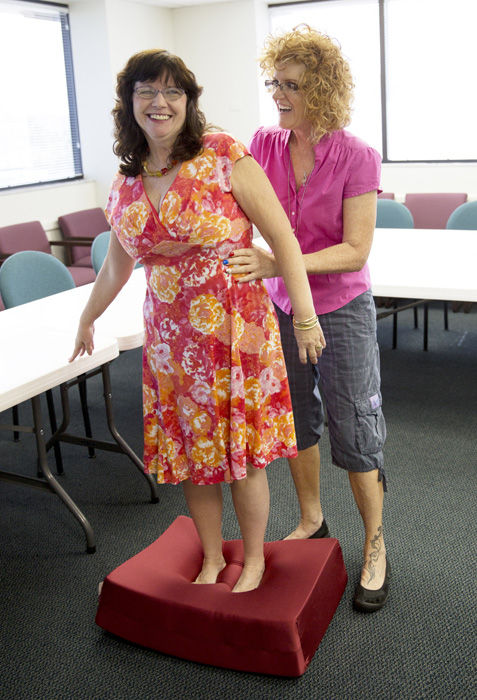Falls. They are the leading cause of accidental death in older Americans.
A pet underfoot, a bundled rug, poor lighting or vision, medications that make a person fuzzy, weakness and problems with balance can all be the culprit.
Falls resulted in some 2.4 million emergency-room treatments across the country last year and over 772,000 hospitalizations, according to the Centers for Disease Control and Prevention. Roughly 20,000 deaths are attributed to complications resulting from falling over.
And the costs are not just in terms of a person’s health. In 2012, the price tag of fall injuries tabulated at emergency rooms, from care-giving, rehabilitation and more was over $36 billion.
“It’s a big problem,” said Cory Richter, battalion chief of Indian River County Fire and Rescue, whose department responded to a staggering 1,200 calls for falls – or roughly four each day – last year. Many calls were for people who had fallen previously.
To curb the number, Fire and Rescue, the Florida State Health Department in Indian River County, the Senior Resource Association and the Visiting Nurses Association of Indian River County are teaming up to promote education on the matter, and by doing so, hoping to prevent some falls. They are seeking a $20,000 grant for doing needs assessments at 50 people’s homes and installation of some basic safeguards and equipment that can help the elderly stay upright.
While injuries frequently are minor – skin tears, bruises and the like – they can also be catastrophic. Older people breaking bones can be a recipe for disaster. And if they hit their head, they can even be fatal.
Richter, who is instrumental in the statewide injury prevention program, said it’s important to educate people on preventive measures, especially those who fall repeatedly.
“If they need grab bars or if they need rugs removed – little things like that can make a big difference,” he said. “They feel they don’t need these things, but they really do. They’ve lived there for so long, they just don’t see these things as issues.”
In addition, the fear factor can drive denial in some older people.
“Some of them are embarrassed,” he said. “They don’t want to acknowledge what the problem is. They are afraid they will lose their independence. If they admit they are slipping three times a week and falling, they are afraid they will end up in a nursing home. That’s probably the biggest fear with the elderly – losing their independence if they admit they fall.”
Physical therapist Margaret Olsen is manager of the therapy department at the Visiting Nurses Association here and often works with patients who have fallen.
“People have to realize that falling is not an inevitable part of aging,” she said. “A lot of falls can be prevented.”
A tendency to trip up can be rooted in medications, poor vision or weak muscles from inactivity or various ailments. Sometimes environmental hazards are also a possible cause, or at least a contributor.
In such cases the situation can be improved by making simple changes such as better lighting, caution tape on steps, removal of loose rugs or adjustments in meds.
“You can become more vulnerable if you don’t do some maintenance, such as getting eyes checked, getting medications checked,” she said. “A lot of people aren’t quite sure what their deficits are until someone tells them. They think they are fine.”
Olsen works closely with people on doing exercises to strengthen themselves and address their balance disorders. Strengthening doesn’t always succeed but she can help them to learn to use other parts of their body or rely more on their sensory system. “We can use what is working,” she said.
And building up confidence can go a long way. “The fear of falling again can be a barrier to getting better, the psychology of it. Fear can be incapacitating.”
The Senior Resource Association has an emergency 211 Sunshine program, in which a senior can be called on a daily basis at an appointed time. If there’s no answer, someone from the group will visit the home to check on that person.
If a senior’s family member or a friend observes problems with falling over, the association will send a case manager to assess the home and see what can be done to remove obstacles, improve lighting or install equipment such as grab bars. The grant would help pay for this.
“A fall can be the start of their demise,” said Karen Deigl, executive director of SRA. “They can break a hip, or other bone, and those injuries can escalate into a whole other realm of problems.”
Leah Sweat, doctor of physical therapy at Advanced Motion Therapeutic in Vero Beach, says about 40 percent of her clients have fallen, and they tend to be 65 and older.
“For many of them, they had repeated falls which served as a ‘wakeup call’ alerting them that something is off,” she said.
“They got scared about their safety, and they realize something more serious could come of it,” such as losing their independence if they break a limb and have to go to rehabilitation or a long-term facility for assistance.
Physical therapists help people negotiate issues at home or replicate home tasks at the clinic, instilling a mix of caution and confidence. “They can improve considerably,” says Sweat.

